Revell's 1/32 scale
Messerschmitt Bf 109 G-6
by Ron Petrosky
|
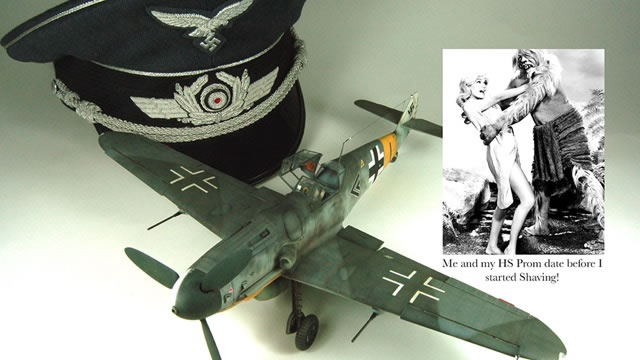
|
Messerschmitt Bf 109 G-6 |

Revell's 1/32 scale Bf109 G-6 is available online from Squadron.com for only $23.99!
The Revell 1/32nd Messerschmitt Bf 109 G6 #04665 and a personal history of WWII Luftwaffe models, Morlocks and encounters with the Eloi
By Ron Petrosky.
What can I say about the Me 109 that hasn’t been said here on Hyperscale, in countless books and magazines, in on-line articles, written on subway and bathroom walls (Sorry Simon and Garfunkel) before? Answer: Nothing! So, I won’t write about it.
I can and will give you some personal perspective about my fascination with the Me109 and WWII Luftwaffe aircraft and personalities in general so you can better understand some of us older modelers with similar interests.
Being born in 1947 and considered a “Baby Boomer”, there was plenty of lingering interest, coverage, recollections and an overall Zeitgeist about World War two in my youth. Many of our Dads, Uncles, teachers, and others were vets of the European and Pacific theaters. So…. we youngsters in the US were immersed in the television series and movies of the time dealing with the subject: Victory at Sea, Airpower, Navy Log, etc. on TV. Movies like Twelve O’clock High, Battleground, Sahara, The Dam Busters, Sink the Bismarck, A Wing and a Prayer and many, many more, also seen on TV. All of these took the allied slant on the war and rightly so. It was the good fight against unspeakable evil and horror, no hand wringing, hesitation, or confusion about who the enemy was or doubt about the cause. I found the history of WWII all too compelling.
Maybe because my Dad, who was also an airplane modeler, was an aerospace worker with Sperry Flight Research on Long Island at the time (later with Republic Aviation on L.I. and Lockheed in California) I developed a fascination with airplanes from a very early age (or maybe I was a reincarnation of someone who was in the military during WWII as my Brother’s mystical Russian girlfriend believes!). Couple that with the fact that I was an odd kid never in step with the mainstream interests of my contemporaries (After school Clubs, Sports! What’s that? Get on the bus or walk back home to my models and aviation history books!). Always “different” I guess, it was almost natural for me to be drawn to the more unusual side of aviation history while inordinately ensconced in my Dad’s basement workshop (which caused some of my friends to give me the nickname “The Morlock”).
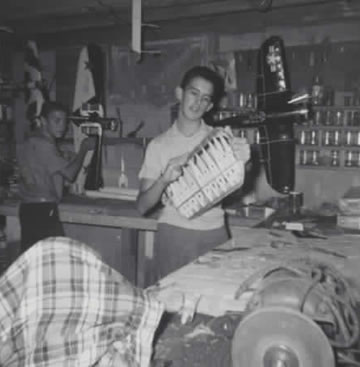
Me (“The Morlock”) in the basement shop working on a control line airplane kit wing which also became a part of my modeling repertoire along with plastics. Younger brother Glenn in background faking interest. He was “normal”, He played above ground, baseball and football in High School.
Some of the first books I read in my subterranean lair while comfortably seated next to a wood burning pot belly stove with my tea and Pepperidge Farm orange cookies (miss them!) were; “I flew for the Fuhrer” by Heinz Knoke and “The First and the Last” by Adolf Galland. These books reflected a very different view of aerial combat during WWII from the stereotyped views of the Germans and Japanese I had been exposed to up to that time in movies and TV. I started reading everything I could get my hands on from the German (especially) or Japanese perspective (‘Zero” by Caiden, Okuma and Horikoshi and “Samurai” by Caiden and Sakai comes to mind). This “alternative history” seemed very exotic to me.
At the same time, I was building plastic airplane models from Revell, Lindberg, Monogram, Hawk, Aurora, etc. Later I discovered Airfix…. fairly accurate Me110s, Ju88s, He111s! Also, coincidently, my 7th grade junior high school English teacher, Mr. Gimigliano, was an avid modeler and a WWI and WWII history enthusiast and shared my interest in the Luftwaffe, related models and books. As a youngster himself during the war, he constructed beautifully carved and wonderfully painted wooden fighter plane models in about 1/72nd scale as I recall and brought these to school for us to see. To see his brush painted, Lindberg JU88 and Me262, which he brought to class to show us boys as he finished them, was awe inspiring. He also brought in his collection of color post cards from Germany during WWII that depicted Luftwaffe aircraft and crews. I was hooked. Mustangs, Thunderbolts, Lightnings, P-40s, B-25s, B-17s? … how pedestrian and obvious for an American boy! (OK, I built those and Spitfires and Hurricanes too).
What aircraft was more iconic of the WWII Luftwaffe than the Me 109? Answer: None! What aircraft had such an interesting evolution in camouflage and markings? Answer: None! (OK, sit down and relax, just my opinion…yeeesh!) That’s why I have built more Me 109 models than any other subject in my approximately 63 years of modelling starting with that horrible red Aurora “Barely Me109” model to the subject at hand.
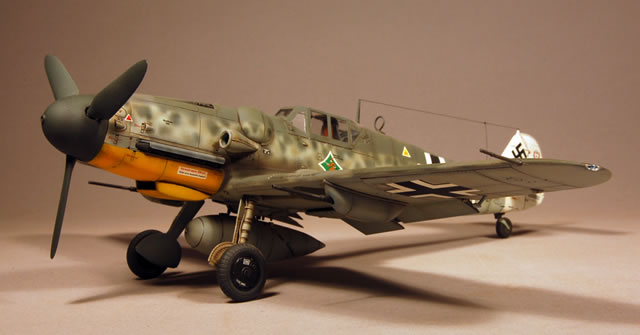
My Hasegawa 1/32nd scale Me109 G6 in the EagleCals markings of Grislawski’s machine.
Lastly, my Mom and also my Dad, (a WWII US Army infantry veteran who fought in France and Germany), was somewhat concerned about my interest in German WWII stuff although my Dad was more tolerant because he was able to admit I was “different”. Emotions were still raw for many who fought in the war or were among those on the “home front” as late as the 50’s and early 60’s. My Mom asked Mr. Gimigliano during a teacher/parent meeting if he was going to have us read “Mein Kampf”! I was so embarrassed when my Mom told me that…. I nearly died. “Mr.G” was very understanding. To this day there are some who think that an interest in WWII Luftwaffe or Wehrmacht modeling subjects are somehow an endorsement of the Nazis and their atrocities. Poppycock, Humbug! (nonsense).
The Model, Finally!
There have been so many reviews of the Revell 1/32 Me 109G there’s no reason to go into a detailed description of the kit. There are some very positive and a few negative aspects of the kit that should be mentioned. First the Positive. The price! We are stealing these kits! Hasegawa Me109G at discount is 59 US dollars vs. Revell at 25 US dollars. I bought 3 Revell kits when they were released! Comparing the two (I built both) Revell has to make no apology for the quality of their offering. Great cockpit, surface detail, etc. Accuracy is generally very good. You get a very nice Me109G right out of the box.
The negatives are the much-discussed canon bulges over the cowl machine guns, the exaggerated fabric patches on the control surfaces, some lack of finesse in the shape of the oil cooler under the cowl, the spinner, propeller blades, supercharger intake, etc. If you were to show the finished stock kit to all but the avid Me109 rivet counter they’d probably say, “Hey, that’s a really cool Me109!”.
We lovers of aftermarket stuff and who are so ashamed if we don’t respond to criticisms we read about kits, and have to make some attempt to correct things, spring into buying action…. it’s nearly a biological imperative! Sometimes we are even compelled to add scratch-built detail! That’s so we can show that same person our Me109G and point out everything we did only to have that person say, “Hey, that’s a really cool Me109!”. It’s why I am going to tell you what I did to enhance the kit. You understand and I hope you think the final result is “cool”.
The Upgrades
When the Me109 “Experten” got to review the Revell kit (I purchased three immediately!) and analyze its faults, Alley Cat released an upgrade kit consisting of 47 resin and photo-etch parts designed to correct those faults. In the heat and fever of AMS (Advanced Modeler Syndrome) corrective passion, I purchased two of these sets as soon as they were released. When the Me109 “Experten” got to analyze the Alley Cat set and its faults, particularly the cowl gun bulges, I put them aside and started “supplementing” them. I figured if I buy enough stuff…. some of it has to be good! Good thing we are able to steal the kit at 25 US dollars!
What I finally wound up using on this build was the Aires cockpit #2189, Barracuda cast Prop spinner and blades #32122, Intake and exhausts #32155, Prop alignment jig #32171, Cowl gun bulges #32154, and Bf 109G wheels-ribbed hub/ribbed tires #32072, Eduard #632 035 20mm Cannon Pods and masks, the elevator as well as the ailerons from the Alley Cat set which has those nasty raised simulated fabric inspection circles removed. Strangely, photos of the built model on the side of the kit box show a tail wheel with the rubber/leather boot but it is not included in the kit! I used an Aires tail wheel from their wheel set for the 109G6 #ARS2029.
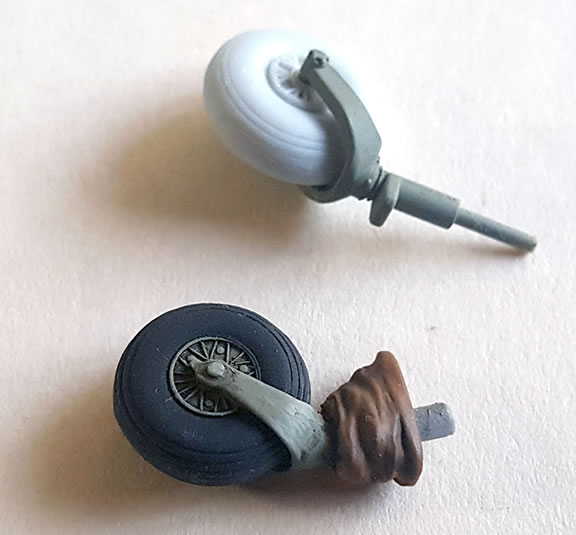
According to Aero Details book on the 109G the Revell part (upper) is OK for wooden tail assemblies on G6s and G10s but metal tail assemblies of the G6 (early) are more commonly seen with the leather or rubber boot as seen on the Aires offering (below).
The Aires cockpit was a pain in the posterior to fit in the model. They do an incredible job of molding and detail but do they ever actually attempt to fit the stuff in the model? I did a lot of scraping, gluing, removing, repairing, re-scraping, pushing and shoving to get the finished cockpit in the model! A few Scotch’s and many bad words (Oh heck! darn it! Oh for Pete’s sake!) later I got it in the model but there are still some gaps that thankfully are mostly hidden. Ugh!
The Barracuda Stuff is wonderful. Beautifully cast, accurate and a drop-fit, it’s definitely worth the expense. Compare the spinner to the kit’s or the Alley Cat spinner, and the quality and accuracy of Roy’s products are immediately obvious. The Alley Cat cowl gun bulges are just plain awful in my opinion. Roy’s are accurate, well defined, ‘fit like a charm.
Eduard’s gun pods are beautiful. They can be built closed or open. Casting is faultless. I’ve heard some criticism of the size of the pods but they look good to me. They do seem to match the BF109G drawings I have listed below.
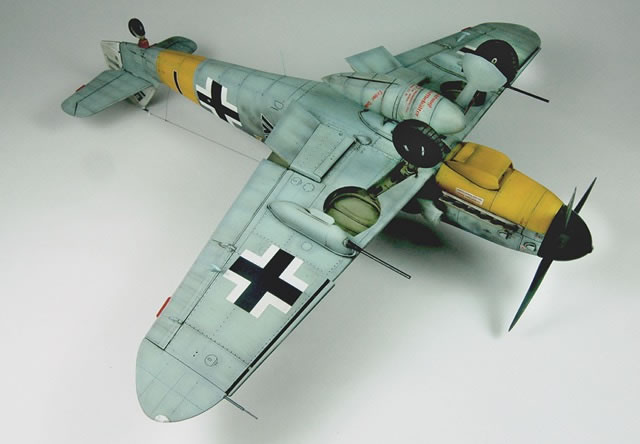
I riveted the whole model using the excellent “Rosie the Riveter” tools. How some of you have the patience to emboss very realistic flush rivets one at a time using a graving tool like the one that comes from MDC Models I will never know. I nominate you for Hyperscale Modeling Sainthood (you can put an HMS before your surname, e.g. HMS Smith, not to be confused with a British ship though).
Anyway, my 25-dollar Me109G is now probably a 125+-dollar gold plated project but at Hasegawa’s price it could have been 150+-dollars so I saved money….!
I had a few sets of EagleCal decals for the Me109G in 1/32nd scale and out of those I picked Anton “Toni” Hackl’s early “G” machine. (‘done to death I know, including Brett’s awesome Hasegawa rendition, but I don’t have one in my build history so it’s fine by me). Hackl was one of the West Front’s Experten with 87 victories there out of a total of 192 confirmed victories on all fronts, 32 of which were four engine bombers. I have read a great deal about the Luftwaffe pilots who intercepted the B-17s and 24s bombing Germany and flying against hundreds of 50 cal. gun positions was a pretty dangerous undertaking. It got much worse for the Germans when the P-51 and P-47 showed up as escorts. That’s why there weren’t too many Experten left at the end of the war. Hackl was shot down 8 times, wounded four times but survived the war and passed away in 1984.
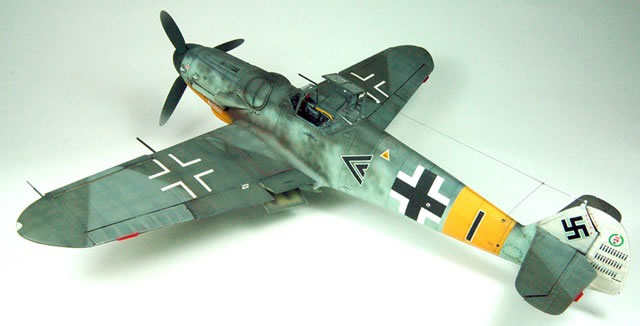
I followed (with a bit of artistic license) the paint scheme depicted in the excellent instructions in the EagelCal sheet. I have no idea what the serial number of this A/C was nor the plant in which it was built so I trust Jerry Crandall did his usual good research regarding the camo scheme. I do assume because of the fuselage mottling and the upper camo shapes depicted in the EagleCal instructions that the aircraft was produced at the Messerschmitt Regensburg plant.
I used Testors enamel for the RLM 76 and Aeromaster enamels for the RLM 02, 04, 74 and 75. Tamiya provided the white. As usual, everything was sprayed with my Passche H-1 powered by a CO2 Tank. Weathering done with wiped oil washes, Prisma colored pencils, pastels, etc.
EagleCals are excellent, very well researched, great full-color instructions. ‘tough enough to move around while applying (unless you are in a rush, see below) but snuggle really well into panel lines and around raised detail. I do use a bit of decal set on all decals over a coat of Future followed by another coat of Future over the decals when set and dry. After a layer of Testors Dullcote the decal film disappears and markings look painted on.
I did make a booboo when I tried to apply decals before the first layer of Future was completely cured. I sprayed the Future on pretty heavily in the morning and in the late afternoon, in a fever to see how the markings would look, I started to apply the national markings. I use Champs decal set and, unfortunately, the decal set melted the Future and trying to move the decals on jellied Future doesn’t really work well at all (a sarcastic understatement). I cracked the markings so many times I nearly ran out of balkenkreuzes! I removed the broken decal on the port side of the fuselage and those under the wings by pulling it up with making tape and let the Future cure for a couple of days. Result, a nice thin crater the shape of the decal down to the level of the paint on the port side of the fuselage! I resprayed the area with Future a couple of times and fine-sanded after each layer had cured fully. After allowing the future to cure for a couple more days the EagleCals behaved the way they always have on fully cured Future…. Excellent! Age Old Lesson: by rushing you make errors that cause you to spend more time fixing them and that makes you drink more Scotch and say bad words again!
Final Thoughts
If you want to build an excellent 1/32nd scale Me109G out of the box and can live with some accuracy dings on detail parts, the Revell 1/32nd kit is a great kit, especially for the money. There’s a ton (literally) of aftermarket stuff designed expressly for this kit and I highly recommend the Barracuda Cast stuff for one source. I am very glad to have this one to add to my ‘109 modeling experience. Based on what you get for the price, I’d give the kit four and one-half stars. Good ‘ole/new Revell!
PostScript: During my last semester in High School a very sweet, beautiful, smart young “Eloi” girl (a friend of my Brother’s girlfriend) bravely ventured down into my gloomy basement lair and started asking “The Morlock” questions about his models. She eventually led me by the hand into the sunlight and to my H.S. Senior Prom and a wonderful summer of ’65. (see guys, modeling makes you a “chick magnet!” They actually seek you out, even underground! Yeah, right! LOL). Modeling took a break during my beginning encounters with the fair sex and four years of US Air Force service. I now have a beautiful, smart, young (at heart), wonderful “Eloi” lady who was brave enough to actually marry me and who has supported my modeling (and my ridiculous model stash and book collection!) for 44 years. My hobby room is now above ground! My wife says that some days she doesn’t see me much but at least she knows where I am! (Weena could have said the same thing about Morlocks and would have been thankful for not seeing them! Hey, maybe my wife is too!). Just kidding…. Thanks Honey ….
If you don’t know about the Eloi, Weena and Morlocks read H.G. Wells’ “The Time Machine” or watch the 1960 classic movie version with Rod Taylor and Yvette Mimeux .
References:
-
Shigero Nohara et al., Aero Detail #5 Messerschmitt BF109G, 1992
ISBN 499-20589-1
-
Dariuz Karnas, Scale Plans #9 Messerschmitt 109G2 & G6, 1/48 and 1/32,
ISBN 978-83-63678-49-4
-
Krzysztof Janowicz, Kagero Monograph #22 Bf 109G/K Vol. II, 2005
ISBN 83-89088-92-4
-
Jochen Prien & Peter Rodeike, Messerschmitt Bf 109F, G, & K Series, 1993
ISBN 0-88740-424-3
-
Hans-Heiri Stapfer & Don Greer, Messerschmitt Bf 109G Walk Around #43, 2006
ISBN 0-89747-503-8
Model and Text Copyright ©
2018 by Ron Petrosky
Page Created 19 February, 2018
Last Updated
19 February, 2018
Back to
HyperScale Main Page

|
Home
| What's New |
Features |
Gallery |
Reviews |
Reference |
Forum |
Search